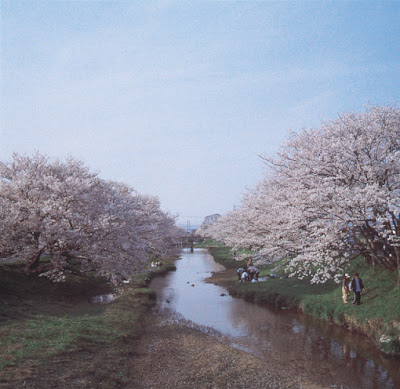 |
| cherry trees and my family temple |
Two periods of seven days with the middle day falling on the spring or autumn equinox are called Higan(彼岸), which means "the other shore" or Buddhahood. I visited my family grave with my family on the 22nd.
Cherry blossoms were almost in full bloom in my family temple. It's rare to see blooming cherry blossoms during Higan.
cherry trees and graves
 |
| photo by Miyagi Prefecture Tourism Division |
Kinkasan (金華山), Miyagi Prefecture
Predicted flowering period: mid April to mid May
Kinkasan (金華山, Kinkasan or Kinkazan) is a small sacred island off the Oshika Peninsula in Miyagi Prefecture. The island is covered with primeval forest. It's only the workers of Koganeyama Jinja Shrine(黄金山神社) who live in the island.Wild deers and monkeys live there. The deers have been regarded as the messengers of a deity, so they are wandering around the shrine.
A man posted his experience of the Great East Japan Earthquake of 11 March 2011 on the island. He and his friends headed for higher ground amid aftershocks shortly after the quake, facing the peril of falling rocks. There was a memorial monument of the 1933 Sanriku earthquake on the ground. They took shelter temporarily in the shrine. The shrine provided a room and meals to visitors. On the 12th, a sightseeing boat came to pick up them, and they crossed the sea to the peninsula.
"The world's longest row of cherry blossom trees"
Hirosakidake Ajigasawa Line of Aomori Prefectural Route 3, Hirosaki City, Aomori Prefecture
Predicted flowering period: early to mid May
About 6,500 cherrt trees are planted along a stretch of about 20 km.
 |
| The world's longest row of cherry blossom trees |
Hirosaki Cherry Blossom Festival will be held at the Hirosaki Park from April 23rd to May 6th. Hirosaki Park includes Hirosaki Castle constructed in 1611 and its grounds.
Predicted flowering period: late April to early May
 |
| Hirosaki Park |
 |
| Hirosaki Park |
 |
| Hirosaki Park |
 |
| Hirosaki Park |
| Hirosaki Park |
 |
| Hirosaki Park |
| Hirosaki Park |
 |
| Hirosaki Park |
 |
| Hirosaki Park(cherry blossom tunnel in the west moat) |
 |
| Hirosaki Park(cherry blossom tunnel in the west moat) |
Hayakakenuma Park(早掛沼公園), Mutsu City, Aomori Prefecture
Predicted flowering period: late April to early May
 |
| Hayakakenuma Park |
Higashi Cemetery(東霊園, Higashi Reien), Hachinohe City, Aomori Prefecture
 |
| Higashi Cemetery |
Kasamai Ohata Cherry Road(来さまい大畑桜ロード), Mutsu City, Aomori Prefecture
Ashino Park(芦野公園), Goshogawara City, Aomori Prefecture
Predicted flowering period: late April to early May
about 250-year-old Igawa Ipponzakura(井川の一本桜), Hamada City, Shimane Prefecture
 |
| Igawa Ipponzakura |
Tamayu River(玉湯川), Matsue City, Shimane Prefecture
Predicted flowering period: late March to mid April
banks of the Mitoya River(三刀屋川河川敷), Unnan City, Shimane Prefecture
Predicted flowering period: late March to late April
about 300-year-old weeping cherry at Senju-in Temple(千手院), Matsue City, Shimane Prefecture
about 660-year-old Misumi Obirazakura(三隅大平桜), Hamada City, Shimane Prefecture
It's designated as a national natural treasure.
Predicted flowering period: late March to early April
 |
| Misumi Obirazakura |
about 340-year-old Danbe weeping cherry(段部の枝垂れ桜), Unnan City, Shimane Prefecture
banks of the Hii River(斐伊川), Unnan City, Shimane Prefecture
Predicted flowering period: late March to mid April
 |
| banks of the Hii River |
 |
| banks of the Hii River |
about 200-year-old Tennozakura(天王桜) at Ono Tsushima Jinja Shrine(小野津島神社), Kamo-
gun, Gifu Prefecture















